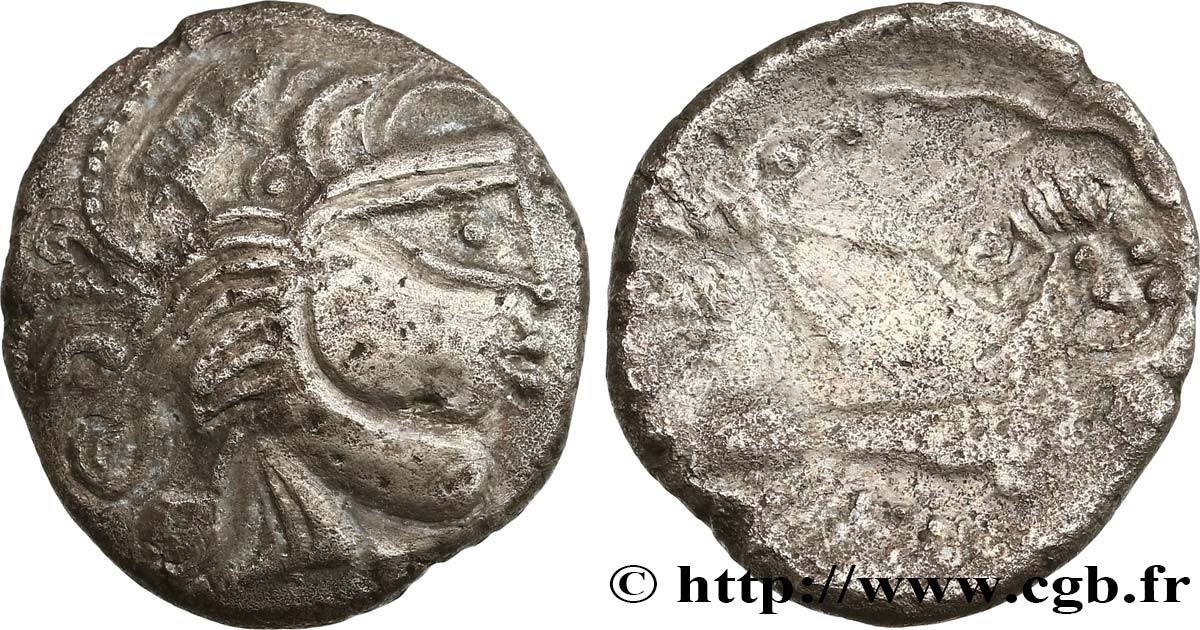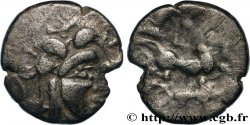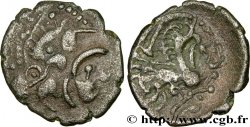bga_479769 - GALLIEN - ARMORICA - BAÏOCASSES (Region die Bayeux) Statère d’argent au sanglier et à la lyre
Menge
In den Warenkorb

Type : Statère d’argent au sanglier et à la lyre
Datum: IIe - Ier siècle AC.
Name der Münzstätte / Stadt : Bayeux (14)
Metall : Scheidemünze
Durchmesser : 21 mm
Stempelstellung : 12 h.
Gewicht : 5,28 g.
Seltenheitsgrad : R3
Kommentare zum Erhaltungszustand:
Bel exemplaire au style inhabituel dans le traitement du portrait au droit. Joli revers. Patine grise
N° im Nachschlagewerk :
Vorderseite
Titulatur der Vorderseite ANÉPIGRAPHE.
Beschreibung Vorderseite Tête humaine à droite, les cheveux en grosses mèches ; un sanglier dans la chevelure ; cordon perlé enroulé devant le visage.
Rückseite
Titulatur der Rückseite ANÉPIGRAPHE.
Beschreibung Rückseite Cheval androcéphale galopant à droite ; une lyre entre les jambes ; restes de l'aurige au-dessus du dos ; vexillum devant la tête.
Kommentare
Ce statère s’intègre dans le monnayage tardif de la Basse Normandie, du Cotentin et de Jersey, sans pour autant correspondre exactement à aucune des monnaies publiées !
Le type à la lyre est traditionnellement plutôt attribué aux Abrincatui, mais le style ne leur correspond pas. Comme pour le statère aux deux lyres, n° 662 de MONNAIES 53, ne serait-il pas possible que ce statère soit un "mélange" de Baïocasses et d'Abrincatui, deux peuples mitoyens ?.
This stater is part of the late coinage of Lower Normandy, Cotentin and Jersey, without corresponding exactly to any of the published coins! The type with the lyre is traditionally attributed to the Abricatui, but the style does not correspond to them. As for the stater with two lyres, no. 662 of MONNAIES 53, would it not be possible that this stater is a “mixture” of Bayocasses and Abrincatui, two adjoining peoples?
Le type à la lyre est traditionnellement plutôt attribué aux Abrincatui, mais le style ne leur correspond pas. Comme pour le statère aux deux lyres, n° 662 de MONNAIES 53, ne serait-il pas possible que ce statère soit un "mélange" de Baïocasses et d'Abrincatui, deux peuples mitoyens ?.
This stater is part of the late coinage of Lower Normandy, Cotentin and Jersey, without corresponding exactly to any of the published coins! The type with the lyre is traditionally attributed to the Abricatui, but the style does not correspond to them. As for the stater with two lyres, no. 662 of MONNAIES 53, would it not be possible that this stater is a “mixture” of Bayocasses and Abrincatui, two adjoining peoples?








 Berichten über einen Fehler
Berichten über einen Fehler Die Seite drucken
Die Seite drucken Teilen meiner Auswahl
Teilen meiner Auswahl Stellen Sie eine Frage
Stellen Sie eine Frage Einlieferung/Verkauf
Einlieferung/Verkauf
 Details
Details











